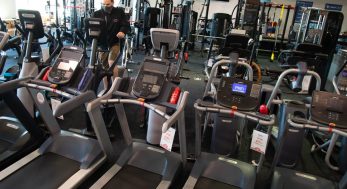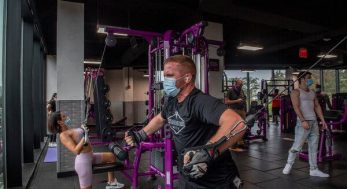Barbell snatches are one of the Olympic lifts. It’s the first exercise in weightlifting competitions, and a popular lift with athletes looking to increase muscle power. Power is your ability to move heavy weights very quickly.
However, the barbell snatch is also a difficult exercise to master. In addition, poor posture, tight pecs and lats, and lack of general lower body flexibility can mean that some lifters find this exercise almost impossible to do correctly.
The good news is that the single-arm dumbbell snatch is almost as effective and a whole lot easier to learn.
Here’s why and how to do it.
The advantages and benefits of the single-arm dumbbell snatch
Dumbbell snatches are a very valuable exercise. Whatever your fitness goals, adding this exercise to your workouts will help you reach them sooner. The main advantages and benefits of dumbbell snatches are:
No special equipment required– dumbbell snatches are very accessible. For barbell snatches, you need a proper lifting platform and a barbell with shock-absorbing bumper plates. Not all gyms have these things. In contrast, single-arm dumbbell snatches are much more gym-friendly, and you can even do them at home.
Increased coordination and balance– while easier to learn than barbell snatches, dumbbell snatches still require a good level of coordination and balance. With practice, you should see your coordination and balance increase. That will have a positive impact on your movements outside of the gym, such as when you are playing sport.
Increase speed and power– dumbbell snatches teach you to lift weights explosively. This will improve your ability to run faster, throw further, jump higher, and hit harder. if you play sports, dumbbell snatches could help improve your athletic performance.
Cardio and fat burning– a high-rep set of dumbbell snatches will leave you out of breath and your heart pounding. It’s a good exercise for high-intensity interval training and circuit training.
Can help identify and fix strength imbalances– single-arm dumbbell snatches will soon reveal if one side of your body is stronger than the other. Doing this exercise regularly can help correct any imbalance. Strength imbalances can cause postural problems and injuries.
A good way to build bigger shoulders and traps– this exercise really challenges your shoulders and traps. If you want a more powerful-looking upper body, this exercise can help you achieve it.
Muscles worked during dumbbell snatches
Dumbbell snatches are essentially a full-body exercise. In fact, it’s hard to think of many muscles that aren’t active during this movement. However, the primary muscles used are:
- Quadriceps – quads for short, these are the muscles on the front of your thigh. They are responsible for knee extension.
- Hamstrings – located on the back of your thigh, the hamstrings are responsible for knee flexion and hip extension.
- Gluteus maximus – also known as your glutes or butt, this large muscle works with your hamstrings to extend your hip joint.
- Erector Spinae – the collective name for the muscles that run up either side of your spine. These muscles work together to stop your spine flexing forward during dumbbell snatches.
- Trapezius and rhomboids – the trapezius is the kite-shaped muscle of the upper back. It helps stabilize the shoulder girdle and upper spine. The rhomboids are located under the trapezius and are between the shoulder blades. They pull the shoulder blades inward toward each other.
- Deltoids – there are three deltoid muscles; anterior or front, posterior or rear, and medial or middle. All three are involved in lifting the weight overhead and stabilizing your shoulder joint.
- Core – the collective term for the muscles of the abdominals and waist. Because dumbbell snatches are a single arm exercise, the core muscles have to work extra hard to maintain lumbar stability and balance. The oblique or waist muscles and the Quadratus Lumborum or deep waist muscles are especially active.
How to do single-arm dumbbell snatches properly
To get the most from this exercise, you need to do it right. If you make a mistake, a potentially heavyweight could come crashing down on your head! Avoid problems by practicing this exercise with a small dumbbell and making sure you have lots of clear space around you before you start.
1– Place a dumbbell on the floor and then stand astride it, feet shoulder-width apart.
2– Squat down and grip the dumbbell firmly with one hand. Drop your hips, lift your chest, brace your abs, and straighten your arm. Look straight ahead or slightly upward. This is your starting position.
3– Keeping your arm straight at first, explosively stand up to lift the weight off the floor. As the dumbbell approaches hip-height, bend your arm and pull it upward.
4– Once you have pulled the dumbbell as high as you can, bend your knees, drop under the weight, and catch it overhead. Your arm should be straight.
5– Stand up with the weight held above your head. If you have to press it up, the weight was too heavy, or you didn’t lift the dumbbell fast or hard enough. The weight should travel from the floor to overhead in one smooth movement.
6– Lower the weight down to your shoulder and then return it to the floor. Do another rep with the same arm, or swap hands as required.
How to program the one-arm dumbbell snatch
While you could just grab a nearby dumbbell and get snatching, you’ll get better results if you adjust your weights, sets, and reps to match your training goals. Apply the following guidelines to your dumbbell snatch workouts.
- For power and strength: 4-6 sets of 3-5 reps using heavyweights. Rest 2-3 minutes between sets.
- For hypertrophy (muscle size): 3-5 sets of 6-12 reps using moderate to heavyweights. Rest 60-90 seconds between sets.
- For fat burning, fitness, and muscular endurance: 2-4 sets of 13-20 reps using light to moderate weights. Rest 30-60 seconds between sets.
Alternatives and variations
The single-arm dumbbell snatch is a beneficial exercise, but that doesn’t mean it’s the only version of this exercise you should do. In fact, studies suggest that exercise variety is essential for making continual strength and muscle-building progress (1). Spice up your dumbbell snatch workouts with these alternatives and variations.
Single-arm dumbbell snatch from hang
For this variation, each rep starts with the dumbbell at around knee height, literally hanging from your extended arm. This variation emphasizes your upper body, and you’ll really feel it in your traps.

Double-dumbbell snatch
If you have mastered single-arm snatches, why not try using two dumbbells? Start with your weights on the floor or in the hang position as preferred. Lifting two dumbbells at the same time requires even more coordination and balance.
Kettlebell snatches
No dumbbells? No problem! Use kettlebells instead. When you do kettlebell snatches, the weight flips over your wrist at the top of each rep. This requires and increases shoulder stability and strength. You can also do this exercise using two kettlebells, and from the hang position described above.
Single-arm barbell snatches
This snatch variation is easier than it looks! Simply hold your barbell in the exact center and snatch as normal. The long bar is much more unstable and unwieldy, so don’t use too much weight too soon. This is a good exercise for increasing balance and stability.
The wrap-up
Whether you want to jump higher, run faster, punch harder, build bigger delts and traps, or just burn fat and get fit, single-arm dumbbell snatches can help. They might look tricky, but after just a few minutes of practice, you should be able to do this exercise confidently and comfortably. It’s a fun, productive movement and, once mastered, you’ll be surprised at just how much weight you can lift from the floor to over your head with one arm and in one, smooth movement.
1- Fonseca, Rodrigo M.; Roschel, Hamilton; Tricoli, Valmor; de Souza, Eduardo O.; Wilson, Jacob M.; Laurentino, Gilberto C.; Aihara, André Y.; de Souza Leão, Alberto R.; Ugrinowitsch, Carlos (2014-11). “Changes in Exercises Are More Effective Than in Loading Schemes to Improve Muscle Strength”. The Journal of Strength & Conditioning Research. 28 (11): 3085. doi:10.1519/JSC.0000000000000539. ISSN 1064-8011. https://journals.lww.com/nsca-jscr/fulltext/2014/11000/Changes_in_Exercises_Are_More_Effective_Than_in.9.aspx
Tags: CrossfitCrossFit WorkoutDumbbell SnatchSingle-Arm Dumbbell Snatch

